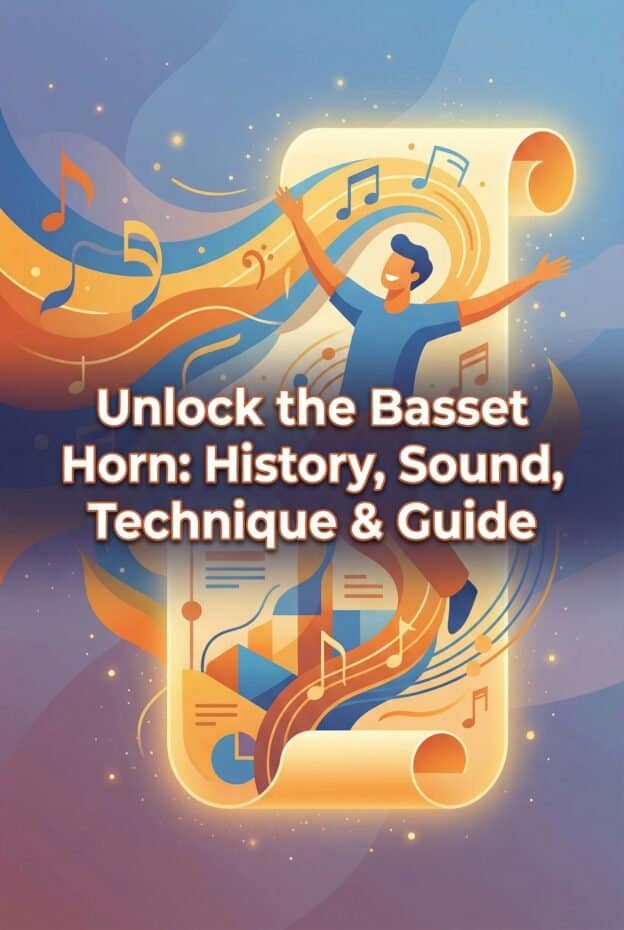A Basset horn is a lower-pitched member of the clarinet family, typically in F with an extended low register. It combines a darker, mellow tone with a larger bore and distinct keywork that allows notes below the standard clarinet's lowest E, often down to written low C or B.
What is a Basset Horn?
The basset horn is a mid-low clarinet-family instrument, usually pitched in F, with an extended lower range and a characteristically veiled, warm tone. It uses a single reed and cylindrical bore like other clarinets, but its length, bends, and keywork give it extra low notes and a more introspective sound favored by Mozart and later composers.
Historically, the term “basset horn” covered several related instruments with extended lower ranges. Modern use usually refers to the F basset horn with a range from written low C or B up to at least high C, notated in treble clef and sounding a perfect fifth lower than written. Players often double from B-flat or A clarinet, adapting embouchure and air support.
Typical modern basset horn range: written low C (sounding F2) up to at least written C6, giving about 4 octaves of usable compass.
History and Evolution of the Basset Horn
The basset horn emerged in the late 18th century, probably in central Europe around the 1760s. Early examples appear in sources cataloged by RISM and in surviving instruments in collections in Vienna and Prague. These early basset horns were often built in boxwood with brass keys and had narrower bores than most modern F instruments.
By the 1780s the basset horn had become a favorite color in Vienna and Munich. Wolfgang Amadeus Mozart used it extensively, as documented in the Neue Mozart-Ausgabe (NMA). Works such as his Masonic Funeral Music K. 477 and the Requiem K. 626 include important basset horn parts, often written for virtuosi like Anton Stadler and the Stadler brothers.
Early basset horns varied widely in shape and pitch. Some were straight with a small metal bell, others had multiple wooden sections with sharp bends. Pitches included G and A, but the F basset horn gradually became standard. Makers in Germany and Bohemia experimented with bore sizes and key systems, leading to regional designs documented in Grove Music Online and museum catalogs.
In the early 19th century the basset horn remained in use with composers such as Ludwig van Beethoven and Franz Danzi, especially in Harmoniemusik and wind serenades. However, as the clarinet family standardized and the bass clarinet developed, the basset horn's popularity declined, surviving mainly in a few orchestral and operatic scores and in regional bands.
The late 19th and early 20th centuries saw a near eclipse of the instrument. Many parts were rewritten for alto or bass clarinet, and some original basset horn manuscripts were lost or misattributed. Library of Congress and European archives preserve scattered parts, often mislabeled as clarinet in F or alto clarinet. Interest persisted among a few collectors and historians.
A modern revival began in the mid 20th century, driven by historically informed performance and renewed study of Mozart's original scorings. Instrument makers developed reliable modern basset horns in F with Boehm and German systems. Contemporary composers, including Karlheinz Stockhausen and György Ligeti, added new works, and recordings helped reestablish the instrument's identity.
Martin Freres field note: Archival research in the Martin Freres collection shows 19th-century French catalog listings for “cor de basset” alongside early alto clarinets. While Martin Freres focused primarily on soprano clarinets, these documents confirm that French makers tracked the basset horn trend, even as the instrument remained more central in German-speaking regions.
Instrument Anatomy: How the Basset Horn Differs from Other Clarinets
Anatomically, the basset horn sits between the soprano clarinet and the bass clarinet. It is longer than a B-flat clarinet, usually with a bent body and a metal or wooden crook. Most modern instruments are in F, using a standard B-flat or specially designed F mouthpiece and a single reed, with a bore larger than soprano but smaller than bass clarinet.
The body typically consists of a mouthpiece, a metal crook or bocal, upper and lower joints, and a curved or bulb-shaped bell. The bends shorten the overall height, making the instrument manageable in playing position. Keywork includes extra levers and pads to reach the extended low notes, often down to written low C or B, operated by the right-hand little finger and sometimes the left hand.
Compared with a standard clarinet, the basset horn's bore is wider and longer, which lowers the pitch and darkens the tone. The bell is often smaller and more conical than a bass clarinet bell, contributing to a focused, less boomy low register. Modern designs may use grenadilla, cocobolo, or synthetic materials, while historical instruments were often boxwood with fewer keys.
Mechanically, the extended lower notes are achieved through additional tubing and tone holes below the normal clarinet's low E. These holes are covered by large pads connected via long key arms. Because of the length and complexity, pad seating and mechanical stability are more critical than on soprano clarinets, especially around the low C and B tone holes.
Typical bore diameter: B-flat clarinet about 14.6-15.0 mm, basset horn about 15.5-16.5 mm, bass clarinet about 18.0-19.0 mm, depending on maker and system.
Players often ask how the basset horn compares with alto and bass clarinets. Alto clarinet in E-flat has a similar visual profile but a higher pitch and usually no extended basset range. Bass clarinet in B-flat is larger, with a deeper, more resonant tone and a heavy floor peg. The basset horn occupies a unique timbral niche between these instruments.
Comparison table: basset horn vs other clarinets
The following comparison highlights key differences relevant to players and conductors.
| Feature | B-flat clarinet | Basset horn (F) | Alto clarinet (E-flat) | Bass clarinet (B-flat) |
|---|---|---|---|---|
| Transposition | Sounds M2 lower | Sounds P5 lower | Sounds M6 lower | Sounds M9 lower |
| Typical lowest written note | E3 | C3 or B2 | E3 | C3 or B2 |
| Bore size | Small | Medium | Medium | Large |
| Body shape | Straight | Bent with crook | Bent with crook | Bent with long lower joint |
| Typical material | Grenadilla | Grenadilla / boxwood (historic) | Grenadilla / ebonite | Grenadilla / composite |
| Primary role | Solo & orchestral | Coloristic & chamber | Band & some chamber | Orchestral & solo |
Suggested diagram for readers
For teaching or research, a labeled diagram is valuable. Include labels for mouthpiece, ligature, reed, crook/bocal, upper joint, lower joint, register key, right-hand trill keys, low E/B, D/C, and C/B keys, and bell. Mark the extended low tone holes to visualize how the basset extension is added to the standard clarinet tube.
The Sound: Tone, Range and Acoustic Characteristics
The basset horn's sound is its defining feature. Players and listeners often describe it as smoky, veiled, or vocal, with a gentle attack and a smooth legato. Compared with B-flat clarinet, the tone is darker and less brilliant, especially in the chalumeau and throat registers. Compared with bass clarinet, it is lighter and more flexible, with a clearer core.
In terms of range, most modern basset horns run from written low C or B up to at least written C6, giving roughly four octaves. The extended low notes have a particularly haunting quality, which Mozart exploited in his Masonic and sacred works. The clarion and altissimo registers can be surprisingly agile and bright when voiced correctly, making the instrument versatile in chamber settings.
Acoustically, the F transposition and medium bore place the basset horn in a sweet spot of the clarinet family. It blends exceptionally well with voices, violas, and horns. In classical-period Harmoniemusik, it often reinforces inner lines, while in modern scores it may function as a solo color. The bent body and smaller bell reduce some of the directional projection of straight clarinets.
Intonation tendencies differ from soprano clarinet. The extended low notes can be unstable if the instrument leaks or if the player uses insufficient air support. Throat tones may be flatter, and some clarion notes sharper, depending on bore design. Skilled players learn to manage these tendencies through voicing, alternate fingerings, and fine embouchure adjustments.
Many modern basset horns are built to A=440 or A=442 Hz standards; always confirm pitch with the maker, especially when pairing with period instruments tuned around A=430-438 Hz.
Repertoire and Notable Works (Classical to Contemporary)
The basset horn repertoire is richer than many players realize, though scattered across archives and editions. Classical-era works form the core, with Mozart as the central figure. The Neue Mozart-Ausgabe and Library of Congress catalogs list numerous chamber and orchestral pieces with authentic basset horn parts, often misprinted in earlier editions.
Mozart's key works include the Masonic Funeral Music K. 477, the Requiem K. 626, the Gran Partita K. 361, and several divertimenti and Harmoniemusik pieces. He also wrote trios and ensemble works specifically featuring basset horns, such as the Trio in E-flat major K. 498 “Kegelstatt” in arrangements and related chamber settings that use the instrument.
Other Classical and early Romantic composers include Franz Danzi, Antonio Salieri, Ignaz Pleyel, and Carl Stamitz. Many wrote Harmoniemusik with two basset horns, often preserved in RISM-listed manuscripts. Beethoven used the instrument occasionally in early works and arrangements, though many later editions substitute clarinets or alto clarinets.
In the 19th century, the instrument appears in operatic and sacred contexts. Some works by Felix Mendelssohn and Richard Wagner include parts originally conceived for basset horn or closely related instruments. Researchers should consult critical editions and facsimiles to verify whether parts labeled “clarinet in F” or “corno di bassetto” are true basset horn parts.
The 20th and 21st centuries have seen a modest but important revival. Composers such as Karlheinz Stockhausen, György Ligeti, Luciano Berio, and Harrison Birtwistle have written solo and chamber works for basset horn or basset clarinet in F. IMSLP and publisher catalogs list an increasing number of contemporary pieces, including solo works, duos, and mixed ensembles.
For practical programming, clarinetists often adapt alto or bass clarinet parts to basset horn when the tessitura and color suit the instrument. Conductors should be aware that authentic basset horn parts often sit higher than bass clarinet parts and require a player comfortable in the clarion register, not just the low register.
Recommended recordings and editions
For stylistic reference, listen to historically informed recordings of Mozart's Requiem and Masonic works using period basset horns. Modern recordings by leading European orchestras often feature specialist players on F basset horn. For scores, consult critical editions from major publishers and digital archives such as IMSLP for public-domain parts.
Playing Techniques and Fingering Tips for the Low Register
Transitioning from B-flat clarinet to basset horn is straightforward in many respects, but the extended low register requires specific technique. The longer tube and extra keys demand more air support, stable posture, and careful hand position. Many players underestimate the air needed for a resonant low C or B, leading to weak or unstable tone.
Embouchure should be slightly more relaxed than on B-flat clarinet, with a fuller lower lip cushion and an emphasis on open throat and steady air. Avoid biting to compensate for the larger reed and mouthpiece. Instead, think of supporting the sound from the diaphragm and keeping the oral cavity tall, similar to singing a low vowel.
For the lowest notes, ensure that both hands are relaxed and that right-hand pinky keys are fully depressed. Because the mechanism often chains several pads together, incomplete key closure easily causes leaks. Practice long tones on low F, E, D, C, and B with a tuner, focusing on even response and pitch stability at different dynamics.
Fingering charts for basset horn largely mirror those of the B-flat clarinet, with added fingerings for the extended low notes. Some makers use alternate key layouts for low C and B, so consult the instrument's fingering chart. Many players adopt slightly different fingerings for throat tones and clarion notes to improve intonation on specific models.
Articulation in the low register benefits from a lighter tongue and more legato connection. The length of the tube can make staccato feel slower. Practice slow, soft tonguing on low notes, gradually increasing speed while keeping the air constant. Slurred intervals between low and middle registers may need extra voicing adjustments to avoid cracks.
For advanced players, alternate fingerings in the clarion and altissimo registers can improve tuning and color. Some basset horns respond better to bass-clarinet-style fingerings for certain notes. Keep a notebook of effective alternates for your specific instrument, especially for exposed passages in Mozart or contemporary works.
Suggested 3- and 6-month practice milestones
After 3 months of regular practice, aim to play all scales through the extended low range at moderate tempo with consistent tone, and to perform simple Mozart or Danzi lines in tune with piano. After 6 months, target full control of low C/B at varied dynamics and comfort in chamber repertoire with confident intonation.
Maintenance and Setup: Daily Care, Reeds, Mouthpieces and Pads
Basset horn maintenance follows clarinet principles but needs extra attention around the extended low joint and bent sections. Daily care should include careful swabbing, checking for moisture in the crook, and wiping keywork. Because of the longer air column, condensation can accumulate in bends and cause gurgling or water in tone holes.
After each session, remove the mouthpiece and swab it separately. Then swab the crook and each joint individually, using a swab long enough to pass the bends without snagging. Avoid pulling a swab forcefully around tight curves; if resistance is felt, reverse direction to prevent it from getting stuck.
Apply cork grease sparingly to tenon corks as needed, usually weekly or when assembly feels tight. Over-greasing can attract dust and degrade cork. Inspect pads visually, especially the large low pads, for signs of moisture, warping, or compression. Gently blot wet pads with cigarette paper or pad paper without pulling.
Key oiling should be done every few months or as recommended by your technician. Use a light key oil on pivot screws and rods, avoiding excess that can migrate to pads. Seasonal checks are important, since the long body and multiple joints are more sensitive to warping and misalignment than a soprano clarinet.
Reed and mouthpiece selection is critical. Many players use slightly softer reeds than on B-flat clarinet to accommodate the larger facing and longer tube. Typical setups might be strength 2.5 to 3.5 on a mouthpiece with a moderate tip opening and medium-long facing. Some prefer dedicated basset horn mouthpieces; others use bass clarinet or B-flat clarinet mouthpieces designed for F instruments.
For intonation, small adjustments at the crook or barrel can make a large difference. Pulling out slightly can help high notes, while pushing in can stabilize the low register. Some players use thin shims or tuning rings under the mouthpiece to fine-tune pitch without changing the basic setup. Always adjust after the instrument is fully warmed up.
Storage should maintain stable humidity, ideally around 40-60 percent relative humidity. Use a quality case that supports each joint and protects the bent sections from stress. When transporting, avoid placing heavy items on top of the case, and consider a backpack or wheeled case for longer distances to reduce the risk of impact damage.
Troubleshooting Common Issues (intonation, leaks, key action)
Common basset horn problems include unstable low notes, intonation inconsistencies, and sluggish key action. Because of the extended mechanism, leaks around the low C and B pads are frequent culprits. A simple diagnostic is to finger low C or B and gently press around the pad cups; if the sound changes, a leak is likely.
Intonation issues often appear in the throat and clarion registers. Flat throat tones may benefit from alternate fingerings, slightly firmer embouchure, or voicing adjustments. Sharp clarion notes can sometimes be tamed by slightly pulling out the crook or by using alternate fingerings documented in professional fingering charts for F basset horn.
Sticky keys, especially on bent instruments, usually result from moisture, pad surface issues, or misaligned springs. Clean key edges and tone hole rims carefully with a soft cloth. For temporary relief, use pad paper to absorb residue. Persistent sticking should be addressed by a technician, who may adjust spring tension or pad seating.
Uneven tone across joints can indicate misaligned tenons or leaks at joint connections. Assemble the instrument carefully, making sure alignment marks are followed. If the sound changes dramatically when you gently twist the joints, the tenon corks may be worn or compressed. A technician can replace corks and reseat joints.
On the field, simple fixes include using cigarette paper to dry pads, checking that all screws are snug but not overtightened, and verifying that the register key closes fully. Temporary cork shims can sometimes improve a loose joint before a concert, but they are not a substitute for proper repair.
Know when to consult a specialist. If low notes suddenly disappear, if the instrument plays significantly out of tune despite good technique, or if keywork feels loose or noisy, schedule a professional service. Given the complexity of the mechanism, annual or biennial checkups are advisable for regularly used basset horns.
Buying, Renting and Sourcing a Basset Horn – What to Look For
Finding a quality basset horn can be challenging, since production numbers are low compared with B-flat clarinets. Professional players should prioritize established makers with experience in low clarinets. Decide early whether you prefer Boehm or German (Oehler) system, aligning with your primary clarinet system and regional practice.
When trying instruments, evaluate intonation across the full range, especially the extended low notes and throat tones. Check response at soft dynamics in the low register and at forte in the clarion. A good basset horn should speak easily on low C or B without excessive embouchure adjustment and should blend well with piano or strings.
Inspect build quality: key fit, pad seating, and the robustness of long key arms. Pay particular attention to the crook and its connection points, which are frequent sources of leaks and mechanical stress. The bell and lower joint should show precise tone hole placement and solid pad cups for the lowest notes.
For used instruments, ask about age, service history, and any previous crack repairs. Examine the bore with a light for signs of damage or heavy wear. Test with your own mouthpiece and reeds if possible, as setup can dramatically affect your impression. Budget for an initial overhaul if the instrument has not been serviced recently.
Rental options are limited but may exist through conservatories, orchestras, or specialized shops. For short projects, borrowing from an institution or colleague can be practical. Collectors and historical-performance specialists sometimes commission replicas of 18th-century basset horns in boxwood for period ensembles; these require different expectations for tuning and keywork.
Expect professional-level modern basset horns to cost several thousand to over ten thousand in local currency, depending on maker, system, and material.
Accessories are also important. Ensure that replacement crooks, cases, and stands are available. A stable floor stand designed for bent clarinets can reduce handling risk during rehearsals. When ordering internationally, confirm pitch standard (A=440/442), system, and keywork options (low C vs low B) in writing.
Resources, Archives and Further Reading
Because basset horn information is scattered, curated resources are invaluable. Grove Music Online provides authoritative historical overviews and bibliographies under entries for “basset horn” and related clarinet-family topics. RISM offers searchable catalogs of manuscripts containing basset horn parts, useful for researchers and performers seeking original sources.
The Neue Mozart-Ausgabe (NMA) is important for anyone studying Mozart's basset horn writing. Critical reports discuss instrumentation, transpositions, and surviving parts. The Library of Congress and major European libraries hold early printed editions and manuscripts, some digitized and accessible online, including Harmoniemusik and sacred works.
IMSLP hosts many public-domain scores with basset horn parts, though users should verify authenticity and instrumentation against scholarly editions. Specialist books on the clarinet family often include chapters on the basset horn, with organological details, fingering charts, and repertoire lists. Academic journals in musicology and performance practice regularly publish case studies and new findings.
Professional clarinet societies and historical-performance organizations sometimes maintain repertoire databases and host conference presentations on the basset horn. Recordings by leading ensembles and soloists provide practical models for phrasing, articulation, and balance. Keeping a personal annotated list of scores and recordings will help you navigate this niche but rewarding repertoire.
Key Takeaways
- The basset horn is an F clarinet-family instrument with an extended low range and a uniquely dark, vocal tone that differs from both alto and bass clarinets.
- Its history runs from late 18th-century prominence with Mozart and Harmoniemusik, through 19th-century decline, to a modern revival in historical and contemporary music.
- Successful playing requires strong air support, careful low-register technique, and attention to specialized maintenance, especially around the extended low keywork.
- Repertoire and reliable instruments are less common than for standard clarinets, so players must use targeted research, careful buying strategies, and curated resources.
Frequently Asked Questions
What is a Basset Horn?
A basset horn is a member of the clarinet family, usually pitched in F, with an extended lower range that often reaches written low C or B. It has a bent body, larger bore than a B-flat clarinet, and special keywork that produces a dark, mellow tone favored in Classical and modern repertoire.
How does a Basset Horn differ from a standard clarinet or bass clarinet?
Compared with a B-flat clarinet, the basset horn is longer, pitched lower (usually in F), and includes extra keys for notes below written low E. Compared with a bass clarinet, it is smaller, lighter, and has a less cavernous tone, occupying a middle ground in pitch and color between alto and bass clarinet.
Which famous composers wrote for the Basset Horn?
Mozart is the most famous basset horn composer, using it in works such as the Requiem K. 626, Masonic Funeral Music K. 477, and the Gran Partita K. 361. Other composers include Danzi, Salieri, Stamitz, and some early Romantic writers, while modern composers like Stockhausen and Ligeti have revived the instrument in contemporary works.
What reeds and mouthpieces work best for the Basset Horn?
Many players use slightly softer reeds than on B-flat clarinet, often strengths 2.5 to 3.5, on a mouthpiece designed for F basset horn or compatible bass/clarinet models. A moderate tip opening and medium-long facing usually balance response and stability. Experiment with several combinations to match your instrument's bore and your embouchure.
How do I maintain and store a Basset Horn?
Swab the mouthpiece, crook, and each joint after playing, blot wet pads gently, and apply cork grease sparingly. Store the instrument in a supportive case at stable humidity around 40-60 percent. Schedule regular technician checkups, especially for the extended low keywork, and avoid impacts or heavy pressure on the bent sections during transport.
Where can I find scores and parts for Basset Horn repertoire?
Look to critical editions from major publishers, the Neue Mozart-Ausgabe for Mozart's works, and digital archives such as IMSLP for public-domain scores. RISM and library catalogs (including the Library of Congress) help locate manuscripts and early prints. Clarinet societies and historical-performance groups often maintain curated repertoire lists.
Is it possible to convert a standard clarinet to play Basset horn parts?
Converting a standard B-flat clarinet into a true basset horn is not practical, since the basset horn has a longer tube, different pitch (usually F), and extended low keywork. Some basset clarinet conversions extend the range of an A clarinet, but these are distinct from F basset horns and do not fully replicate the instrument's sound and role.
What should I look for when buying a used Basset Horn?
Check intonation and response across the full range, especially low C/B and throat tones. Inspect keywork, pads, crook, and bore for damage or wear, and ask about service history. Confirm system (Boehm or German), pitch standard, and lowest note. Budget for an initial overhaul and test the instrument with your own mouthpiece and reeds.







